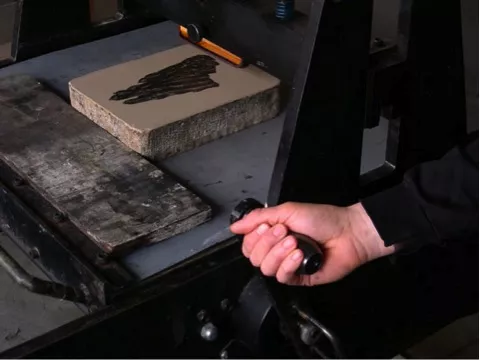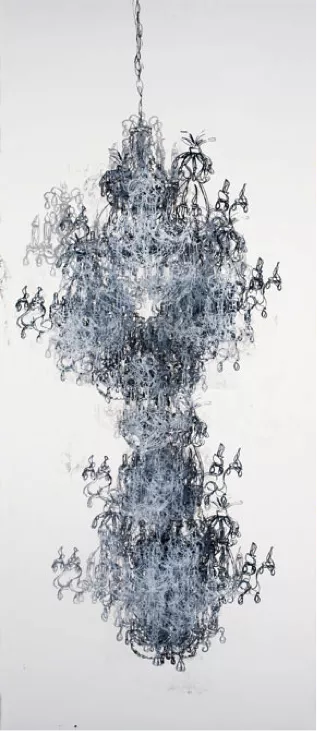Print media covers traditional printmaking (historical information and processes) and introduces new related technologies and approaches (performance, computer and video). Print is approached from a contemporary point of view by faculty who are practicing and exhibiting professional artists. Drawing, research and experimentation inform all levels of print media.
Print Media 1
An introduction to traditional print media such as relief and intaglio processes, within a contemporary context. This course requires experimentation and exploration of contemporary visual concerns, within print. An introduction to performance is a part of the course as is the videotaped document of the performance. The course is designed so that projects will combine research, presentations/discussions and critical thinking.
Course Structure
The studio format is divided into four projects (two per term) investigating monoprinting, relief, intaglio and performance. Critiques occur mid-way and upon completion of projects. Each project deals with specific artistic issues pertaining to contemporary art practice. An introduction to group critiques gives students the ability to create a critical vocabulary
Skills and Techniques
- understanding the workings of a cooperative studio environment
- setting up and using etching presses with and without micrometers
- printing with and without the press (barens)
- proper handling of brayers, rollers and hand tools such as burnishers, triangular scrapers and burins
- a clear understanding of the processes to create an edition from start to finish
- working with relief processes such as monotype, linocut, zincograph and intaglio processes including zinc plate etching
Throughout the year, verbal feedback is given on an individual and group basis. Twice per term, students will submit a portfolio for review. Written feedback and a letter grade is given for each portfolio submission.

Print Media 2
This course expands technical investigations into traditional relief and intaglio and introduces silkscreen printing. Issues of layering and multiplicity are further addressed, as are alternative methods of print including printed ephemera. Analog video and digital imaging (scanning) are introduced. Each project will continue to combine research, discussion and critical thinking. Through the projects students will improve technical skills and critical abilities learned in Print I and prepare themselves for more independent work in Print III.
Course Structure
- the studio format is divided into five projects
- critiques occur mid-way and upon completion of projects
- each project deals with specific artistic issues pertaining to contemporary art practice
- group critiques gives students the ability to develop their critical vocabulary
Skills and Techniques
- more complex understanding of registration and layering
- development of zinc plate etching techniques including chine collé, photocopy transfer
- aluminum plate work with drypoint
- a clear understanding of Water-based serigraph printing
- scanning basics and transfer of image to a photo screen, including comprehension of the relationship of dpi and line screens
- simple bookbinding techniques including an understanding of signatures and signature layout
- analog video information from storyboards, to shots, to deck-to-deck editing
Throughout the year, verbal feedback is given on an individual and group basis. At five points during the year, students will submit a portfolio for review. Written feedback and a letter grade is given for each portfolio submission.
Print Media 3
Course Objectives
Students are helped to learn technical and critical skills along with the development of their own personal vision. They must also increase their familiarity with issues and examples of contemporary print practice.
Course Structure
There are two projects per term, with formal and informal class critiques throughout the term to analyze and discuss the work. Informal discussions with individual students throughout the year monitor and help direct student progress. Professional print portfolios and slide presentations illustrate technical and conceptual print issues.
Technical demonstrations occur throughout the year. In the first term, these consist primarily of lithography and computer demonstrations, but in the second term, demonstrations are directed to individual student needs as sensed by the instructor or defined by the student. In the first term, two technical tests monitor student's mastery of principals and procedures in lithography. In the second term, students must pass a health and safety test. In each term, the student either does a class presentation or an essay, and each project is handed in with notebook, sketchbook and project self-assessment.
Skills and Techniques
Technical skills include stone and plate lithography and Photoshop for colour separations and Premiere for sequencing video stills. Other technical skills will relate to the projects that individual students define.
On completion of the course students should have achieved the following:
- a respectable level of technical accomplishment in lithography
- a consolidation of their skills in other print areas
- to learn to take responsibility for health and safety issues surrounding the production of their work
- the ability to initiate projects generated by their own interests
- become more knowledgeable about issues and examples of contemporary print practice, drawn from class presentations, personal research and gallery and museum visits
- to articulate and critically assess their own work and that of their peers
Print Media 4

Course Objectives
Students are largely involved in a self-directed, supervised opportunity to define and develop their artistic vision in any or all print media. Increased refinement and sophistication in conception and execution is expected. One or two themes should emerge in their prints and in their other work as well, linking and focusing their endeavours.
Students should increase their familiarity with issues and examples of contemporary practice especially as they touch upon their own work and they are expected to attend community forums, particularly those that relate to their projects and to print.
Course Structure
One short, collaborative project will introduce students to Adobe Premiere and DV video and result in a short video. They will then decide, on an individual basis, guided by their enthusiasms and interests, whether to continue in video or to use other print techniques, or both. It is generally useful for students if each term is divided into two projects, although, as with other aspects of Print 4, this is determined by the individual student. There are formal and informal class critiques throughout the term to analyze and discuss the work. Informal discussions with individual students throughout the year monitor and help direct student progress.
Frequent viewing of professional print portfolios and slide presentations illustrate technical and conceptual print issues, and technical demonstrations are given when needed or sought. In each term, the student either does a class presentation or an essay and each project is handed in with notebook, sketchbook and project self-assessment. Each project should have accompanying print ephemera and be documented with slides. In the second term, students must pass a health and safety test.
Skills and Techniques
Introduction to Premiere and DV video to make short videos. Students identify what they want to learn and are then helped to acquire the necessary skills.
On completion of the course students should have achieved the following:
- creation of a body of work with a view to exhibition
- an increased sensitivity to the installation of their work
- a consolidation of their skills in print and a familiarity with video
- the ability to initiate and realize projects generated by their own interests
- the confidence to continue to work independently in a professional setting like an artist-run printshop
- to learn to take responsibility for health and safety issues surrounding
- to have become more knowledgeable about issues and examples of contemporary print practice, drawn from class presentations, personal research and gallery and museum visits
- to articulate and critically assess their own work and that of their peers
